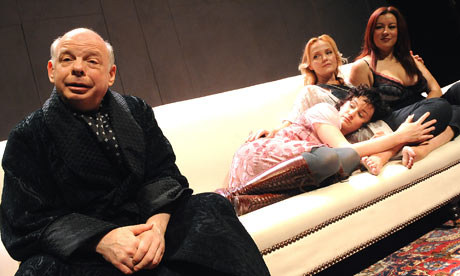This synopsis is from http://thirdrailrep.org/events.php?show=26:
It’s the 10th Anniversary of September 11 and the Apple family find themselves gathered together in Rhinebeck, NY for an impromptu lunch before heading off to an afternoon memorial service. While Uncle Benjamin rehearses for a reading, emotions run the gamut as the Apples catch up on politics (both familial and political), tell ghost stories, tease each other mercilessly, and confront the difficulties of loss. Filled with humor and sorrow, SWEET AND SAD celebrates the challenges of life in 21st century America and features the returning cast from last season’s hit show, THAT HOPEY CHANGEY THING.I'm a huge fan of playwright Richard Nelson and his Apple Family series. In this show, which is second in a set of four plays, the four siblings gather and touch, as best they can, the deepest wounds. There has been a death in the family, divorce, separation, unemployed children, illness, injury, and frustration at economic and professional paralysis. As the play opens, Barbara enters the empty dining room and looks like she's already been crying. Marion, under heart breaking circumstances, has moved into Barbara's house to live with her. Much has happened since the last play and "Sweet and Sad" artfully unfolds.
In addition to the personal tragedies are reflections about 9/11: the loss of intimate friends who have been ritually celebrated and mourned by brother Richard for the past 10 years, and the anonymous thousands killed who are made personal through Barbara's discovery of a set of discarded notebooks found in a secondhand store.
The arrows of emotion and meaning fly quickly in this play. An audience member who is in a happy place, without a "sore spot" from such pain in their own life, might find that the arrows fly past without resonance, missing their mark. But for others, they will feel the sharp sting. I left with tearful eyes.
The questions about 9/11 might seem familiar, but what might transpire if - like Barbara's high school seniors - we were given a whole hour to discuss each one? Hero or victim? Suicide bombers? Suicidal teens? How do the living make peace with their own souls? And how do we fit into the political landscape that we help create and move through?
One thing is for certain: these siblings fly in each other's faces at every turn. They interrupt ruthlessly. They deflect praise with a irritating self-negation. They throw up walls and boundaries where conversation is not permitted, making those psychic walls themselves invisible characters in the play. It's no wonder that boyfriend Tim gets to tell a ghost story: the dead, and our ultimate inability to talk about them, are very much present in tonight's play of "Sweet and Sad."
--dp





.JPG)
.JPG)































